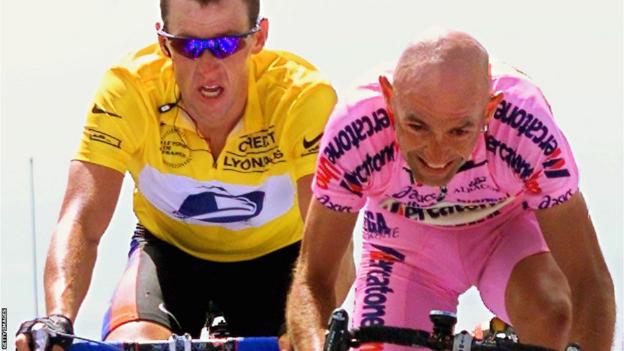
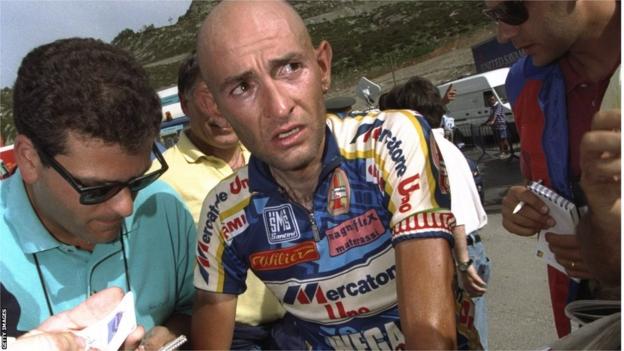
It’s Valentine’s Day – Saturday, 14 February 2004 – but Marco Pantani is alone. He’s holed up in Room 5D of the Residence Le Rose hotel in the Italian seaside resort of Rimini having arrived, out of season, on the previous Monday. Other guests say he’s been behaving erratically.
Pantani was 34 years old, and could have been in the prime of his career; Lance Armstrong, a year and a half his junior, had won the last four Tours de France and would go on to win the next three. But it’s more than three years since the spotlight fell on Pantani, the man whose bandana, shaved head, nose stud and earrings earned him the nickname ‘Il Pirata’ – the Pirate.
Back in his prime, he was professional cycling’s swashbuckling folk hero. In the 2000 Tour de France, he raged against Armstrong’s dominance and his own waning power, surging clear of the American to claim a stage victory in the clean, alpine air of Courchevel. It remains the most-watched day of cycling in Italian television history.
Mid-morning, an increasingly disturbed Pantani has three phone conversations with reception. He’s complaining of being bothered by people in the room next door – which is empty. The last time he calls them, just after 11:00, he asks staff to call the police.
Pantani had the classic climber’s build – skinny, small, sharp cheekbones, and powerful lungs. His ability to thrive in the thin mountain air carried him to victory in both the Giro d’Italia and the Tour de France in 1998 – a double achieved by only six other riders in history. It carved his name alongside the likes of Fausto Coppi, Eddy Merckx and Bernard Hinault in the pantheon of greats.
By 2004 though, a lot had changed. Pantini’s frame had filled out, he was 20kg over his racing weight. He was still a superstar celebrity but his image, for a few at least, had been tainted.
Leading the 1999 Giro d’Italia by more than five minutes with just two stages to go, his race had ended in ignominy, rather than victory.
On the morning of the penultimate stage, he was frogmarched out of the team hotel by Italian police. He had failed a blood test, with the results suggesting he had been doping.
From the hotel balcony, Pantani’s team-mates had cheered their leader. Fans blocked the road in protest at his expulsion from the race.
“I’ve returned from two big accidents, but this time, morale-wise, we’ve touched the bottom,” said Pantani at the time.
This was the fork in the road that led Pantani to Rimini. His world was plunged into darkness that even he couldn’t climb out of.
Later that evening, after consulting the hotel’s owner, the receptionist goes up to Room 5D on the pretext of providing fresh towels. Knocking on the door, there’s no reply from inside. After another conversation with his boss, the receptionist tries again. He unlocks the door with a master key, forces aside the furniture that’s been used to barricade the door from inside, and finds Marco Pantani lying by the bed on the room’s mezzanine level, dead, in a pool of his own blood.
He left behind a legacy of glory, played out in front of an adoring public. But there are also questions. Because not everyone adored Pantani. Some may even have wanted him dead.

Marco Pantani came from an ordinary working-class family in Cesenatico, 14 miles up the Adriatic coast from Rimini.
As a youngster he didn’t always mix well with other children, so a neighbour suggested to his parents that he joined the local cycling club. It was a recommendation that created one of the sport’s greatest climbers.
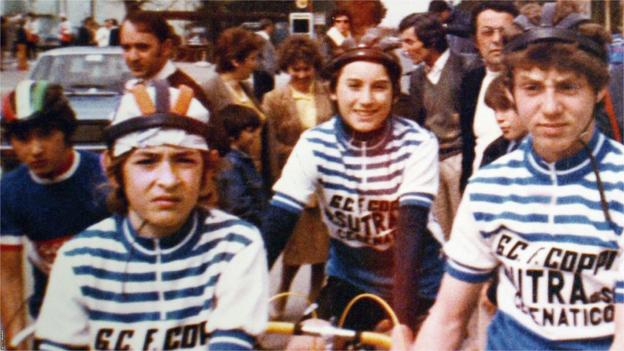
When Pantani came on to the scene, he was seen as a breath of fresh air in comparison to riders like Miguel Indurain and Jan Ullrich, who had dominated through their ability in time trials. They were regarded by the sport’s more romantic fans as ‘winning machines’ – difficult to beat, but also hard to love.
Pantani was the antidote – a climber who left his rivals gasping for breath in the mountains.
Whether it was his fondness for eating Nutella, his refusal to wear a helmet or heart rate monitor, or his predilection for being out late at night singing karaoke when other riders were tucked up in bed, Pantani was different. He was an outsider.
“He wanted to do with his bicycle what an artist did with his paintbrush,” said Pantani’s biographer, cycling journalist Matt Rendell, on BBC Sounds documentary Pantani: Death of a Pirate.
It wasn’t just the success that had millions in his thrall, it was the way Pantani won. It was the style, the panache, the distinctive way he rode up mountains, hunched over the handlebars with his hands on the drops. It was the way he soared away from the rest, seemingly without breaking sweat. The Pirate rode with his heart on his sleeve – all or nothing, death or glory.
After winning a crucial 1998 Giro stage on the summit finish at Montecampione, he explained his all-in race strategy, such as it was.
“I just thought, either it works, or I’m going to blow everything. I had no alternative. I had to see, to know who was the strongest,” he said.
At the 1994 Tour de France, Pantani smashed the record for the fastest ascent of Alpe d’Huez, a near-mythical climb into the heavens, up 21 tight hairpin bends.
In 1995, he produced another exhilarating ride to break it again. In 1997, he came within four seconds of his own record. Those three rides up Alpe d’Huez have never been bettered by any rider in the Tour de France.
His crowning glory came one year later.
The 1998 Tour was a controversial one: a Festina team official had been caught carrying performance-enhancing drugs and the team were expelled, riders were arrested, and the peloton went on strike.
The race was in crisis and needed a hero. Enter Pantani, three minutes behind defending champion Ullrich in the yellow jersey.
On a cold, wet day in the Alps, Pantani turned the race on its head.
Pantani attacked Ullrich on the Galibier, gaining almost three minutes, and flew down the other side of the mountain – taking risk after risk in what must have felt like apocalyptic weather. In his wake, Ullrich played it safe, believing Pantani would crack on the final climb. He didn’t.
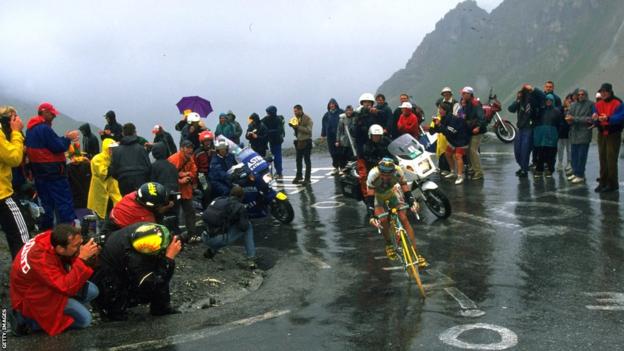
As the live television picture cut in and out, Pantani could be seen storming thorough the fog, up into Les Deux Alpes and to the finish. By the end of that 15th stage, he’d gained nine minutes on Ullrich, whose calculation had proved horribly misjudged.
Pantani’s gamble paid off. He would wear the yellow jersey all the way to Paris.
It didn’t feel like it at the time, but 1998 would prove to be the summit of a career that plummeted unexpectedly 10 months later. Pantani had dominated the 1999 Giro, and looked sure to win with two stages to go, when he was ejected from the race.
The peloton, the press pack and the ‘tifosi’ – Italy’s eager fans – alike were in shock. The Pirate had been denied his coronation in front of the Italian public. His haematocrit levels were two percentage points over the 50% limit which – in the absence of a reliable test for banned blood-boosting drug Erythropoietin (EPO) – was imposed for riders’ health.
Some cyclists who failed tests simply accepted the bans meted out to them as an occupational hazard, served their time, and resumed their career. Others, like Scotland’s David Millar, became advocates for clean cycling.
But for Pantani – only temporarily stood down from racing for failing a ‘health check’ – it was the beginning of the end.
Those close to him say it was then that he started using cocaine on a regular basis.
Indurain, speaking after Pantani’s death in 2004, summed up the next five years in two simple sentences:
“When he had the test for haematocrit he was eventually banned for only 15 days, but it ended up complicating his whole life and he was never able to get over it. He was never the same again.”
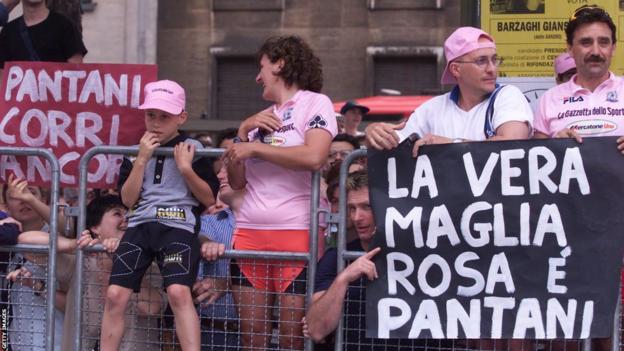
Pantani, while retaining much of his popularity with the public, found himself constantly in dispute with the authorities – cycling’s governing bodies and the Italian government – and became increasingly paranoid, convinced he was being unfairly targeted as cycling attempted to clean up its act.
He was treated in a drugs and depression clinic, and in October 2003 told his fans to ‘forget about Pantani the athlete’.
While on holiday in Cuba, Pantani scribbled in his passport.
“The champion I was exists no more,” he wrote.
“He is far from the man that I have become. If my fans still cheer me, it’s not through affection, but of need of a personality.
“I’ve been humiliated for nothing. For four years, I’ve been in every court. Rules, yes – but the same for everyone.”
Four months later he was dead, and those words became public knowledge after the passport was found in his hotel room.
His death was front-page news. At his funeral, his mother Tonina denounced the media who’d turned up, shouting: “You’re all to blame for my son’s death. What are you doing here?”
Over 20,000 lined the streets of Cesenatico as his coffin was carried out of the church.
An initial investigation into Pantani’s death ruled he died of an accidental cocaine overdose. But it was not the final word on his demise.
A second inquiry began in 2016, prompted by Pantani’s family’s claims that he had been beaten by a group of men, forced to drink cocaine and murdered. It dismissed their theory as “fanciful conjecture”.
But in November 2021, it was sensationally announced that the Italian authorities were opening a third inquiry into events surrounding Pantani – his disqualification from the 1999 Giro, and his death five years later. Its particular focus was whether the mafia were involved.
It was sparked by new evidence, uncovered almost by accident.
“In 2016, there was a wiretapping by a police investigation completely unrelated to Pantani’s case, in which one of the two guys having a conversation mentioned the involvement of the Naples mafia – the Camorra – in Pantani’s death,” investigative journalist Lorenzo Bodrero told Pantani: Death of a Pirate.
Rumours of mafia involvement in Pantani’s death – supposedly connected to the large amount of money the organised crime syndicate was set to lose on unlicensed gambling markets had he won the 1999 Giro – have persisted for years.
Now the police had stumbled on evidence that seemed to support the theory.
There was also testimony from Fabio Miradossa, a dealer who had supplied Pantani with drugs towards the end of his life and got to know him.
“This guy was his pusher, the one who sold the cocaine to him,” explained Bodrero.
“He’s convinced that Marco did not die of natural causes. Miradossa said Pantani did use cocaine, but he was not such a user that would bring himself to death in a matter of a few days.”
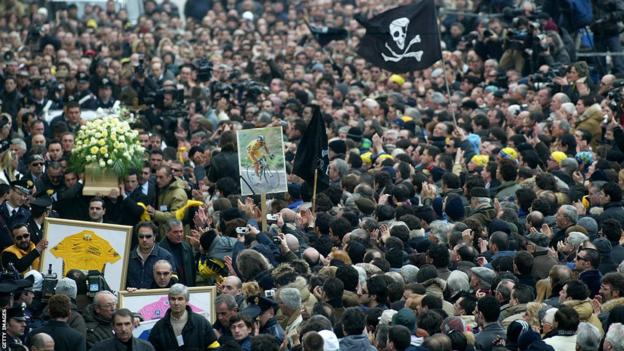
When it came to Pantani’s failed blood test at the 1999 Giro, a well-known criminal claimed his mafia contacts had foreseen the race’s dramatic finale.
“If you have money, bet against Pantani because he’s not getting to [the finish in] Milan” was their reputed advice.
Matt Rendell, Pantani’s biographer, has always been dubious about the rumours of mafia involvement.
“When the Camorra wants to fix something, what it does not do is somehow establish contact with the employees of the haematology department of a hospital in Como,” he told BBC Sounds. “That is not the modus operandi. It’s slightly cruder than that, on the whole.”
But a government commission looking into mafia activities was less sure.
“Today, after this time, the possibility that the mafia may have altered the Giro d’Italia’s results remains an open hypothesis,” said Nicola Morra, the president of the Parliamentary Anti-mafia Commission, in December.
“We have not been able to close as we would have liked. That is, by being able to exclude it.”
The commission had found “several and serious” anomalies around the blood sample taken at the 1999 Giro. They found that the test tube containing Pantani’s blood had been marked with his name when, under rules imposed to guarantee riders’ anonymity, it should have been only identifiable by a number to a select few officials.
The commission had also found that Pantani’s blood sample was taken an hour earlier than indicated in a previous court case, opening a window of time in which his sample could have been tampered with.
“By correctly placing the time of the sampling from Marco Pantani at 07:46, It is possible to manipulate the test tube,” the commission stated.
Of course, it could be that Pantani’s test result was entirely self-inflicted. That the drug testers caught up with a doper.
Christophe Bassons, a French professional cyclist who insisted on riding clean, estimated that 95% of riders were on EPO at the time.
As detection technology improved, his estimate was somewhat backed up by retrospective testing of urine samples collected from the 1998 and 1999 editions of the Tour de France.
Eighteen riders were found to have tested positive for EPO – Pantani among them – with another 12 riders’ results labelled as “suspicious”.
However, some riders of that era were also adept at managing their haematocrit blood tests to stay within the prescribed limits, by dodging drug testers and timing their consumption of EPO.
Pantani was highly unlikely to be a completely clean rider, but it seems he felt, on the day he was led out of his team hotel and out of the 1999 Giro, that he wasn’t cheating any more than his rivals.
His mother says Pantani left notes that back this up.
“He didn’t write ‘I didn’t take it’, he never wrote that,” she told BBC Sounds. “He said he’d do what he was allowed to do, but he never said ‘I didn’t take any’. He said that [on that day] he was OK.”
The perceived injustice of being unable to complete the defence of his title in front of his home fans could have been the start of Pantani’s downward spiral into cocaine addiction and isolation.
There are other anomalies around the circumstances of his death that have never been fully explained.
According to Professor Giuseppe Fortuni, at the time a lecturer in forensic medicine at the University of Bologna, Pantani’s body contained more than six times the lethal dose of cocaine – a quantity that’s almost impossible to take recreationally. Fortuni was the pathologist who carried out tests on Pantani’s body.
But suicide had been ruled out at the time of Pantani’s death – the coroner felt that if that had been his aim, Pantani would have used the prescription drugs that he had with him at the time.
While Miradossa, Pantani’s drug dealer, may not be an altogether reliable witness, he cast doubt on the circumstances Marco’s body was found in.
“I’m convinced that Marco was murdered. He was trying to find the truth. He was looking for something,” he told the Italian government’s Anti-mafia Commission.
“From my experience and from the photos and videos I have seen, Marco did not take drugs in that room.
“There was no equipment for smoking cocaine, which was Pantani’s preferred method of taking it. But there was cocaine in places on his body that suggested that he had sniffed it.”
Miradossa concluded: “Marco didn’t sniff, so whoever did the crime scene wasn’t aware of this fact.”
Tonina Pantani has been central to the push for further investigation into her son’s death.
“I’m convinced Marco didn’t die right there. There were too many things. Strange things…not his habits,” she told BBC Sounds.
“He would fall asleep in front of the TV. In that hotel, the TV was in the hall with couches. I’m sure he didn’t sleep above [in the mezzanine of the hotel room where the bed was and his body found] but below instead.
“Upstairs was all tidy, no mess. But below was chaos. The room was turned upside down. I asked the hotel manager whether there were damages to be paid; he told me, ‘No madam, nothing was broken, everything was simply disassembled’. What the hell were they looking for?
“I saw Marco in the coffin. I touched him, his hands. How on earth did he make such a mess in the room without a scratch? There were scratches on his face that made me wonder whether he’d been beaten before he died.”
Tonina also claimed that her son’s baseball cap was missing, while two jackets that had been found in the room didn’t belong to him.
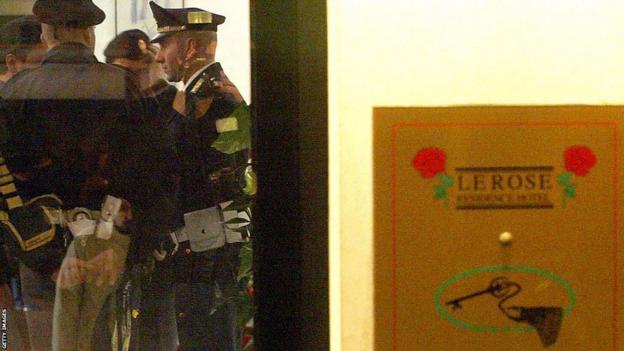
There are more details.
A 2007 book claimed that two aluminium containers at the scene appeared to be takeaway containers that once contained Chinese food – which Pantani was known to detest.
A second entrance to the hotel was reportedly unmonitored by CCTV, potentially enabling any third parties to enter and leave Residence Le Rose discreetly.
A sum of money – some say 20,000 euros (£17,000), others say 12,000 euros (£10,000) – was allegedly missing from Pantani’s room.
Any of these details might be the key to what happened in Room 5D. They all might be dead ends.
There are other, contrasting explanations. Could Pantani, paranoid and under the influence of drugs, have taken the room apart himself? On holiday in Cuba, late the previous year, he had broken furniture while high on cocaine.
John Foot, professor of modern Italian history at the University of Bristol, is one of those who is sceptical that there was more to Pantani’s death than the original accidental verdict.
“I felt a bit sad about the case being reopened,” he told BBC Sounds. “For me it’s a straight case of cocaine overdose and the evidence is pretty powerful.
“I thought ‘here we go, we’re going to down a blind alley and he’s not going to have any peace’.
“They’re going to continue to rummage around in this story and there wasn’t much to go on there.”
The latest investigation into Pantani’s death, attempting to sort theory from reality, is still going on behind closed doors in Rimini. It is unknown when it will report its findings.
Perhaps the only certainty is that it, we and perhaps no-one apart from Marco Pantani will ever know for certain what happened inside that hotel room in Rimini.
The truth may have died with the man, but the legend lives on.
“This extraordinary kid; he didn’t breathe, he didn’t sweat, he didn’t panic… he didn’t even seem to try, but he could just fly away,” remembers Rendell.
“What might he have been in another world, in another life?
“The life that he led and the sport he competed in at the time prevented us from seeing any further.”
If you have been affected by any of the issues in this article you can visit the BBC’s Action Line for information and support.
